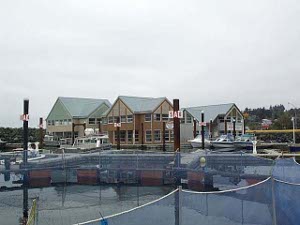 Fish weir and Wharf
Fish weir and Wharf
We visited our friends' boat, M/V Shenandoah, snugly tied up in her marina in Campbell River. She's a comfortable-looking old-time cabin cruiser, with high freeboard and lots of cabin space. Soon our friends will return to go cruising through these fascinating islands and waterways.
 Fish weir and Wharf
Fish weir and Wharf
In the marina we also saw two large fish weirs where some entrepeneur was cultivating fish -- presumably baby salmon.
But our big surprise of the day (we've noticed that we usually can find a good surprise just by nosing around) is the Campbell River Regional Museum. It's been around since the 1960s, but in 1994 got an enormous museum building, erected by the local community and businesses, with help from several government agencies.
We liked this museum much more than the bigger provincial museum in Victoria. It had a story to tell and told it magnificently. It began with the First Nations exhibit (no pictures allowed). The high point was a small dark room, one wall of which was filled with dimly-lit masks. The ceiling was backlit to look like a cloudy evening sky -- or perhaps an underwater effect. As we looked at the masks, suddenly a voice boomed out, speaking a native tongue. We took seats on the benches facing the masks.
 Old logging truck
Old logging truck
Soon the voice shifted to English, and told a story of his ancestor, who descended to the bottom of the sea, was captured by an octopus and taken to the king of the sea, then earned a magical knife by dispatching of several dreaded sea monsters. As each creature the ancestor encountered was named, that mask was spotlit. They were beautifully carved. It was a first-rate artistic performance. When the ancestor returned to his village, he did so in the form of a fish, which was caught by his relatives. The fish spoke to the people, and then the fish opened up, as did the mask, to reveal the human inside. This was a highly artistic portrayal of a First Nations legend.
Throughout this museum we appreciated the work of the curators, who had provided excellent captions, in many cases listing the provenance of each article on display, often with dates.
The rest of the museum told the story of this region -- logging and fishing -- in a graphic way, with absolutely marvelous displays of the working  Fisherman and boat
environments, such as boats and nets and cabins and lumber camps and saws. Oral history had been used to provide quotations from early residents and workers.
Fisherman and boat
environments, such as boats and nets and cabins and lumber camps and saws. Oral history had been used to provide quotations from early residents and workers.
At the start the fisheries were all manned by First Nations people, then more Anglos entered the employment, then Japanese fishermen came, willing to work at lower wages. Eventually the British majority passed laws excluding Asiatics from the industry by denying them licenses.
One Japanese fisherman, whose boat was confiscated in WW II, was able to reclaim the boat and continue fishing until 1987. After he died his family donated the boat to the museum, and it sits out in front, a tiny, neat working boat. Today the grounds of the museum are graced by a Friendship Gate provided by Campbell River's Japanese sister city.
We learned last summer to say yes whenever a museum or visitor center offers a video. Today we spent over an hour watching two videos. The first was an amazing 1914 film made by photographer Edward Curtis, best known for his portraits of Indians. It tells a legend of warring tribes and young love, in a setting featuring the houses, masks, costumes and dances of North Coast Indians.  Friendship Gate
The film crew were all Americans, from the Seattle area, but the actors were First Nations people from British Columbia, and the settings were in British Columbia. The film had been assumed lost until a copy was found in the archives of the Field Museum of Chicago in the 1950s.
Friendship Gate
The film crew were all Americans, from the Seattle area, but the actors were First Nations people from British Columbia, and the settings were in British Columbia. The film had been assumed lost until a copy was found in the archives of the Field Museum of Chicago in the 1950s.
The second, Ripple Rock, tells of the 1958 Canadian national project to destroy a huge underwater rock which had been responsible for the loss of many ships and lives, not to mention the expense of waiting for high tide to pass. The explosion was the largest non-nuclear explosion known, even to this day. This rock had filled the Inlet just to the north of Campbell River. The engineers tunneled under the strait and up through the rock dome, planting explosives throughout a network of tunnels. After the explosion, which any China Laker would have appreciated, Ripple Rock, which used to be at a depth of 9 feet at low tide, was reduced to a depth of 45 to 70 feet, clearing the channel for safe navigation.
Bald eagles are everywhere. It's wonderful to know this magnificent bird has made such a comeback. There's another pair nesting in a tall tree behind our motel.